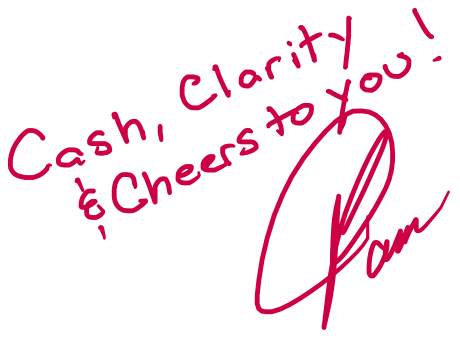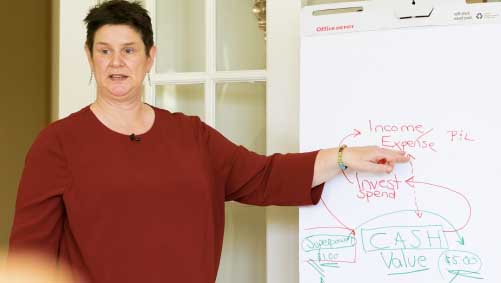
Upside Down Budgeting: Scaling or Failing, Part 1
Alright folks, let’s get real for a second…
If you’re trying to scale your business and find yourself constantly juggling personal and business finances, I’ve got something game-changing for you: Upside Down Budgeting. 🎉
What’s that, you ask?
It’s a complete flip on the traditional way we think about money management.
Here’s the thing:
Most of us let our business finances dictate our personal goals.
Well, let’s turn the tables—let your personal financial goals dictate your business revenue targets.
Sounds wild, right? But thousands of successful entrepreneurs are using this strategy to scale their businesses while staying on track to meet their personal dreams.
And today, I’m going to show you how you can do it too!
In simple terms, upside down budgeting is where your personal financial goals (you know, the stuff you actually care about) drive the revenue targets of your business.
Whether you’re saving for a down payment, a family vacation, or preparing for tax season, this approach helps you reverse-engineer your business objectives with clarity and intention.
KEY POINT 1: Separate, But Aligned Finances—The Dual Bank Account Strategy
First things first, let’s keep those personal and business finances separate (but in sync).
➡️ STEP 1: Open A Separate Business Bank Account
If you don’t already have a separate business bank account, open one TODAY.
Trust me, this is a non-negotiable.
Keeping track of your business transactions is much easier during tax season and allows you to see the profitability of your ventures clearly
➡️ STEP 2: Funnel All Business Income Into This Account
Once you start depositing all your business revenue here, you can easily monitor your cash flow.
You’ll have a transparent snapshot of your business’s financial health—free from the distractions of personal expenses.
KEY POINT 2: Setting Aside Money for Taxes: The Non-Negotiable Step
Don’t let tax season sneak up on you!
A common pitfall for many entrepreneurs is underestimating the amount they owe in taxes.
The good news? Avoiding this mistake is straightforward.
➡️ STEP 1: Calculate Your Marginal Tax Rate
Find out what percentage of your income should be set aside for taxes; consult with a tax professional if needed, but make sure you know how much to save.
➡️ STEP 2: Open a Tax Savings Account
This is your business’s safety net.
Set up an account just for your tax obligations and regularly transfer a portion of your business earnings into it.
Trust me—you’ll thank yourself when tax season rolls around and you’re not scrambling to pull funds together!
KEY POINT 3: Build Your Business Budget Based on Personal Financial Goals
This is where upside down budgeting becomes powerful.
Your business budget should be crafted around the financial milestones you’re aiming for in your personal life.
➡️ STEP 1: Identify Your Financial Milestones
Be clear about what you’re working toward.
Saving for a $100,000 home down payment?
Want to build a $30,000 emergency fund?
These milestones will dictate how much revenue your business needs to generate.
➡️ STEP 2: Map Out Your Business Expenses
Once you know your financial goals, subtract your business expenses (like marketing, subscriptions, rent) from your revenue.
Whatever’s left is what you’ll funnel toward your personal financial milestones.
You’ll need to stay on top of your budget, regularly updating and adjusting as necessary.
Key Point 4: Brick-and-Mortar vs. Online Banks—Which One’s Best for You?
Choosing the right bank is crucial, but the debate between online and brick-and-mortar banks is real.
Pick the option that best aligns with your business needs and personal preferences 👇
➡️ Brick-and-Mortar Banks
Pros:
- Face-to-face service
- In-person support for complex banking needs
Cons:
- Lower interest rates
- Inconvenient if you prefer online or mobile banking
➡️ Online Banks
Pros:
- Higher interest rates
- 24/7 access to your accounts
Cons:
- Lack of in-person support
- Slower issue resolution for complex problems
Conclusion: Flip Your Financial Script
Upside down budgeting requires a mindset shift, but the benefits are well worth it.
When you let your personal financial goals guide your business revenue targets, you’ll have greater clarity, more control, and a stronger focus on what truly matters to you.
Whether it’s separating your finances, saving for taxes, or building a rock-solid budget—these steps will bring you closer to achieving your dreams while scaling your business.
Remember, no more imposter syndrome.
You’re succeeding, and I’m here to help guide you along the way!
Stay tuned for more actionable financial advice, and let’s continue this journey to financial independence and business success, step-by-step.
You got this! 🚀💼
Want more of this? Listen to S5E1 of the “Cash Flow with Pam Prior” podcast on YouTube, Apple Podcasts, and Spotify.

Pam Prior
Author, Virtual CFO, and Finance Coach
“Your First CFO: The Accounting Cure for Small Business Owners” on AMAZON
“Founder to Exit: A CFO’s Blueprint for Small Business Owners” on AMAZON





